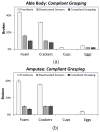Neuromimetic Event-Based Detection for Closed-Loop Tactile Feedback Control of Upper Limb Prostheses
- PMID: 27777640
- PMCID: PMC5074548
- DOI: 10.1109/TOH.2016.2564965
Neuromimetic Event-Based Detection for Closed-Loop Tactile Feedback Control of Upper Limb Prostheses
Abstract
Upper limb amputees lack the valuable tactile sensing that helps provide context about the surrounding environment. Here we utilize tactile information to provide active touch feedback to a prosthetic hand. First, we developed fingertip tactile sensors for producing biomimetic spiking responses for monitoring contact, release, and slip of an object grasped by a prosthetic hand. We convert the sensor output into pulses, mimicking the rapid and slowly adapting spiking responses of receptor afferents found in the human body. Second, we designed and implemented two neuromimetic event-based algorithms, Compliant Grasping and Slip Prevention, on a prosthesis to create a local closed-loop tactile feedback control system (i.e. tactile information is sent to the prosthesis). Grasping experiments were designed to assess the benefit of this biologically inspired neuromimetic tactile feedback to a prosthesis. Results from able-bodied and amputee subjects show the average number of objects that broke or slipped during grasping decreased by over 50% and the average time to complete a grasping task decreased by at least 10% for most trials when comparing neuromimetic tactile feedback with no feedback on a prosthesis. Our neuromimetic method of closed-loop tactile sensing is a novel approach to improving the function of upper limb prostheses.
Keywords: Prosthetics; force feedback; neuromimetic; real-time control.
Figures














Similar articles
-
Myocontrol is closed-loop control: incidental feedback is sufficient for scaling the prosthesis force in routine grasping.J Neuroeng Rehabil. 2018 Sep 3;15(1):81. doi: 10.1186/s12984-018-0422-7. J Neuroeng Rehabil. 2018. PMID: 30176929 Free PMC article. Clinical Trial.
-
Vibrotactile grasping force and hand aperture feedback for myoelectric forearm prosthesis users.Prosthet Orthot Int. 2015 Jun;39(3):204-12. doi: 10.1177/0309364614522260. Epub 2014 Feb 24. Prosthet Orthot Int. 2015. PMID: 24567348
-
Tactile feedback is an effective instrument for the training of grasping with a prosthesis at low- and medium-force levels.Exp Brain Res. 2017 Aug;235(8):2547-2559. doi: 10.1007/s00221-017-4991-7. Epub 2017 May 26. Exp Brain Res. 2017. PMID: 28550423 Free PMC article.
-
Recent Developments in Prosthesis Sensors, Texture Recognition, and Sensory Stimulation for Upper Limb Prostheses.Ann Biomed Eng. 2021 Jan;49(1):57-74. doi: 10.1007/s10439-020-02678-8. Epub 2020 Nov 2. Ann Biomed Eng. 2021. PMID: 33140242 Review.
-
Restoring tactile and proprioceptive sensation through a brain interface.Neurobiol Dis. 2015 Nov;83:191-8. doi: 10.1016/j.nbd.2014.08.029. Epub 2014 Sep 6. Neurobiol Dis. 2015. PMID: 25201560 Free PMC article. Review.
Cited by
-
A hybrid sensory feedback system for thermal nociceptive warning and protection in prosthetic hand.Front Neurosci. 2024 Apr 8;18:1351348. doi: 10.3389/fnins.2024.1351348. eCollection 2024. Front Neurosci. 2024. PMID: 38650624 Free PMC article.
-
The SoftHand Pro: Functional evaluation of a novel, flexible, and robust myoelectric prosthesis.PLoS One. 2018 Oct 15;13(10):e0205653. doi: 10.1371/journal.pone.0205653. eCollection 2018. PLoS One. 2018. PMID: 30321204 Free PMC article.
-
Hierarchical Tactile Sensation Integration from Prosthetic Fingertips Enables Multi-Texture Surface Recognition.Sensors (Basel). 2021 Jun 24;21(13):4324. doi: 10.3390/s21134324. Sensors (Basel). 2021. PMID: 34202796 Free PMC article.
-
Biologically inspired multi-layered synthetic skin for tactile feedback in prosthetic limbs.Annu Int Conf IEEE Eng Med Biol Soc. 2016 Aug;2016:4622-4625. doi: 10.1109/EMBC.2016.7591757. Annu Int Conf IEEE Eng Med Biol Soc. 2016. PMID: 28269305 Free PMC article.
-
Object stiffness recognition and vibratory feedback without ad-hoc sensing on the Hannes prosthesis: A machine learning approach.Front Neurosci. 2023 Feb 16;17:1078846. doi: 10.3389/fnins.2023.1078846. eCollection 2023. Front Neurosci. 2023. PMID: 36875662 Free PMC article.
References
-
- Johansson RS. Sensory input and control of grip. Novartis Foundation symposium. 1998;218:45–63. - PubMed
-
- Hsiao SS, Gomez-Ramirez M. Neural mechanisms of tactile perception. In: Gallagher M, Nelson R, editors. Comprehensive Handbook of Psychology: Volume 3: Behavioral Neuroscience. 2. John Wiley and Sons, Inc; 2012.
-
- Parker P, Scott R. Myoelectric control of prostheses. Crit Rev Biomed Eng. 1986;13(4):283–310. - PubMed
-
- Parker P, Englehart K, Hudgins B. Myoelectric signal processing for control of powered limb prostheses. J Electromyogr Kinesiol. 2006 Dec;16(6):541–548. - PubMed
-
- Englehart K, Hudgins B. A robust, real-time control scheme for multifunction myoelectric control. IEEE Trans Bio Med Eng. 2003;50(7):848–854. - PubMed
Publication types
MeSH terms
Grants and funding
LinkOut - more resources
Full Text Sources
Other Literature Sources
Medical

